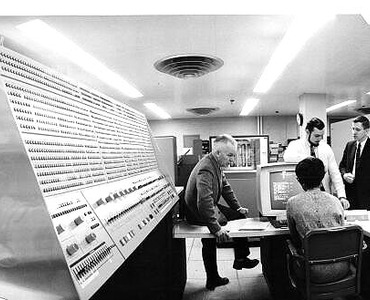Cubic millimeter micromote compared to historic computers
by noreply@blogger.com (brian wang) from NextBigFuture.com on (#2CBQ6)
In 2017, a michigen Micromote computers is one cubic millimeter which is about the size of a large grain of sand. There are several types and are a line of the world's smallest computers. They have one megabyte of flash memory. Their broader goal is to make smarter, smaller sensors for medical devices and the internet of things-sensors that can do more with less energy
Micro mote designs now use only a few nanowatts of power to perform tasks such as distinguish the sound of a passing car and measuring temperature and light levels. They showed off a compact radio that can send data from the small computers to receivers 20 meters away-a considerable boost compared to the 50 centimeter range they reported last year at ISSCC
Another micro mote they presented at the ISSCC incorporates a deep-learning processor that can operate a neural network while using just 288 microwatts. Neural networks are artificial intelligence algorithms that perform well at tasks such as face and voice recognition. They typically demand both large memory banks and intense processing power, and so they're usually run on banks of servers often powered by advanced GPUs.
The Michigan Micro Mote contains solar cells that power the battery with ambient light, including indoor rooms with no natural sunlight, allowing the computers to run perpetually.
 Photo: University of Michigan and TSMC One of several varieties of University of Michigan micro motes. This one incorporates 1 megabyte of flash memory. Previous versions of the micro motes used 8 kilobytes of SRAM
Photo: University of Michigan and TSMC One of several varieties of University of Michigan micro motes. This one incorporates 1 megabyte of flash memory. Previous versions of the micro motes used 8 kilobytes of SRAM
In 1967, the IBM 360 Model 90 shipped with 1 to 4 MB of memory.

In March 1983, IBM announced the IBM Personal Computer XT in New York City. It features a Intel 8088 processor, 10 MB hard drive, eight expansion slots, serial port, 128 kB RAM, 40 kB ROM, keyboard, one double-sided 360 kB floppy drive. Price is US$4995.
In April 1987, IBM Personal System/2 (PS/2) line, with IBM's first 386 PC, and 3.5-inch floppy drives as standard. The Model 30 features 8 MHz 8086 processor, 640 kB RAM, 720 kB 3.5-inch floppy drive, 20 MB hard drive, three expansion slots, PC-DOS 3.3, for US$1695-2295.

Read more










Micro mote designs now use only a few nanowatts of power to perform tasks such as distinguish the sound of a passing car and measuring temperature and light levels. They showed off a compact radio that can send data from the small computers to receivers 20 meters away-a considerable boost compared to the 50 centimeter range they reported last year at ISSCC
Another micro mote they presented at the ISSCC incorporates a deep-learning processor that can operate a neural network while using just 288 microwatts. Neural networks are artificial intelligence algorithms that perform well at tasks such as face and voice recognition. They typically demand both large memory banks and intense processing power, and so they're usually run on banks of servers often powered by advanced GPUs.
The Michigan Micro Mote contains solar cells that power the battery with ambient light, including indoor rooms with no natural sunlight, allowing the computers to run perpetually.
 Photo: University of Michigan and TSMC One of several varieties of University of Michigan micro motes. This one incorporates 1 megabyte of flash memory. Previous versions of the micro motes used 8 kilobytes of SRAM
Photo: University of Michigan and TSMC One of several varieties of University of Michigan micro motes. This one incorporates 1 megabyte of flash memory. Previous versions of the micro motes used 8 kilobytes of SRAMIn 1967, the IBM 360 Model 90 shipped with 1 to 4 MB of memory.

In March 1983, IBM announced the IBM Personal Computer XT in New York City. It features a Intel 8088 processor, 10 MB hard drive, eight expansion slots, serial port, 128 kB RAM, 40 kB ROM, keyboard, one double-sided 360 kB floppy drive. Price is US$4995.
In April 1987, IBM Personal System/2 (PS/2) line, with IBM's first 386 PC, and 3.5-inch floppy drives as standard. The Model 30 features 8 MHz 8086 processor, 640 kB RAM, 720 kB 3.5-inch floppy drive, 20 MB hard drive, three expansion slots, PC-DOS 3.3, for US$1695-2295.

Read more